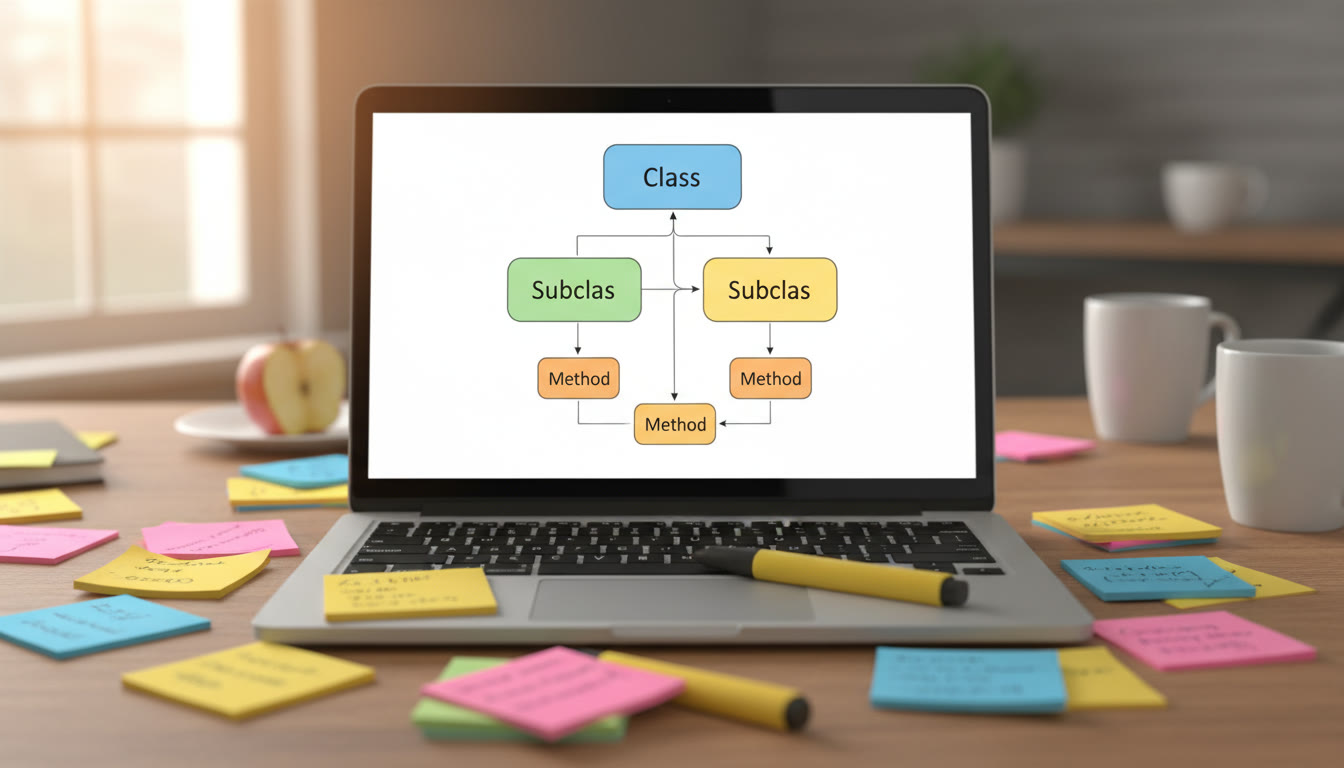Why OOP Matters for AP Computer Science A (CSA)
Object-Oriented Programming (OOP) is the beating heart of modern software design — and a core part of the AP Computer Science A curriculum. If you picture programming as storytelling, OOP gives you characters (objects), traits (fields), actions (methods), and family trees (inheritance). Mastering classes, inheritance, and polymorphism not only helps you score well on the AP exam, it gives you a mental model that makes real-world coding easier and more enjoyable.

What this guide gives you
- Clear, student-friendly definitions and analogies.
- Concrete Java-focused examples that mirror AP CSA style.
- Quick tricks to avoid common exam traps.
- Study strategies and a sample practice table to compare concepts.
- How targeted tutoring (like Sparkl’s personalized sessions) can accelerate learning.
Core Concept: Classes and Objects
Start here — a class is a blueprint; an object is an instance made from that blueprint. Imagine a cookie cutter (class) and cookies (objects). The cutter defines the shape and size; each cookie can have its own frosting or sprinkles, but they all follow the same base shape.
Class anatomy (AP-friendly)
In Java, a class typically contains:
- Fields (variables) — data the object stores.
- Constructors — special methods to create instances.
- Methods — behaviors or actions the object can perform.
- Access modifiers (public, private) — controlling who can see or change data.
Example (conceptually, simplified for AP-style questions):
public class Book {
private String title;
private String author;
public Book(String t, String a) {
title = t;
author = a;
}
public String getTitle() {
return title;
}
}
Key AP takeaways: recognize field declarations, constructor signatures, and accessor methods in code snippets. Expect questions asking for output, state after method calls, or to write short methods following an existing class template.
Core Concept: Inheritance
Inheritance models an “is-a” relationship: a subclass is a specialized version of a superclass. Think: a “Student” is a “Person”; a “Circle” is a “Shape”. Inheritance helps you avoid repeating code and expresses relationships clearly.
How inheritance looks in Java
Use the extends keyword:
public class Animal {
public void eat() { System.out.println("eating"); }
}
public class Dog extends Animal {
public void bark() { System.out.println("woof"); }
}
Dog inherits eat() from Animal. On the AP exam you may be asked to identify which methods are inherited, which are overridden, or to predict output when calls are made on subclass instances.
Constructors and inheritance
Remember: the subclass constructor implicitly calls the superclass no-argument constructor unless you call one explicitly via super(...). A common AP pitfall is forgetting that if the superclass has only parameterized constructors, the subclass must call super with appropriate arguments — otherwise the code won’t compile.
Core Concept: Polymorphism
Polymorphism means “many forms”. Practically, it allows a variable of a superclass type to refer to objects of subclass types and for overridden methods to behave according to the actual object type at runtime. This is essential for flexible, extensible code and frequently appears on AP exam questions about dynamic method dispatch.
Static vs. dynamic binding (quick peek)
- Static binding: compile-time — method signatures and variable types are checked at compile time.
- Dynamic binding: runtime — overridden method calls are resolved based on the actual object type.
Example:
Animal a = new Dog();
a.eat(); // If Dog overrides eat(), Dog's version runs at runtime
AP traps: field access uses the declared type (so a.someField refers to Animal’s fields if any), while overridden methods use the actual object’s method.
Common AP-Style Question Types and How to Tackle Them
1. Predict output
Read code carefully: identify the declared types, the actual object types, and whether methods are overridden. Walk through constructor execution order (superclass before subclass) and note any side effects printed during construction.
2. Identify compilation errors
Check for:
- Mismatched return types
- Missing constructors or incorrect use of
super - Accessing private superclass fields directly from subclasses
- Incorrect method signatures when overriding (must match name, parameters, and return type)
3. Write short methods or classes
AP often asks for small additions: implement a method using existing fields, or add a constructor. Keep your code concise, match visibility and naming conventions, and avoid unnecessary work — clarity beats cleverness in timed settings.
Examples That Build Intuition
Examples are where OOP clicks. Below are AP-style snippets with an explanation of the important parts.
Example 1 — Overriding vs Overloading
Overriding: subclass redefines superclass method (same signature). Overloading: same method name, different parameter lists in the same class.
class Printer {
public void print(String s) { System.out.println(s); }
}
class FancyPrinter extends Printer {
public void print(String s) { System.out.println("*** " + s + " ***"); }
public void print(int n) { System.out.println(n); } // overload
}
Takeaway: overridden print(String) is chosen at runtime based on actual object; the overloaded print(int) is a separate method resolved by the compiler based on argument types.
Example 2 — Polymorphic collections
In AP-style tasks you might see arrays or ArrayList declared with a superclass type but holding subclass instances. This allows unified processing via shared methods.
ArrayList shapes = new ArrayList<>();
shapes.add(new Circle(3));
shapes.add(new Rectangle(4,5));
for (Shape s : shapes) {
System.out.println(s.area()); // dynamic dispatch
}
Each area() call executes the proper implementation for Circle or Rectangle.
Study Strategies: From Concept to Exam-Ready
Active practice beats passive reading
Write small classes, intentionally break code to see compiler messages, and trace examples on paper. Time yourself on short FRQs and multiple-choice sections. Turn mistakes into study items — what caused the error? Was it constructor chaining, a visibility issue, or incorrect assumptions about polymorphism?
Flash drills and mental models
- Flashcards for keywords:
extends,implements,super,this. - Mental checklist when reading code: declared type, actual type, constructor order, overridden methods.
Use focused tutoring when stuck
Targeted, 1-on-1 guidance can close the gap faster than solo practice. Personalized tutoring (like Sparkl’s) offers tailored study plans, expert tutors who can explain subtle Java behaviors, and AI-driven insights to pinpoint weak areas — perfect for students who need a few concept clarifications before reinforcing with practice.
Helpful Table: Quick Reference
| Concept | What to Look For | Common AP Mistake |
|---|---|---|
| Class vs Object | Constructor signatures, field initial values | Confusing class-level variables with instance variables |
| Inheritance | Use of extends, inherited methods and fields |
Assuming private superclass fields are accessible in subclass |
| Polymorphism | Declared type vs runtime type; overridden method behavior | Expecting field values to be polymorphic like methods |
| Constructors | Order of execution, super calls |
Missing calls to required superclass constructors |
| Overriding vs Overloading | Signature match for overriding; different parameters for overloading | Mismatched return type or parameter list when attempting to override |
Exam-Day Tips: Calm, Clear, and Strategic
Before the test
- Review common code patterns and constructor rules.
- Do a light practice set the evening before, then rest — last-minute cramming often backfires.
During the test
- Read questions twice. For code-tracing items, annotate the snippet with variable states as you go.
- If unsure whether a method overrides one in a superclass, compare signatures character-for-character: same name, same parameter types, compatible return type.
- When time is tight, answer multiple-choice quickly by eliminating impossible options and flag FRQs to return after finishing easier parts.
Real-World Context: Why Employers Care
OOP is not just academic — it’s how large codebases stay organized. Inheritance and polymorphism allow teams to build flexible systems where new features plug in without rewriting core code. If you master these AP concepts, you’re learning patterns that transfer directly to internships, projects, and future classes.

Common Misconceptions — Debunked
Misconception: “Inheritance is always the best choice”
Not necessarily. Inheritance should express a true “is-a” relationship. If you’re stealing code because it’s convenient, composition (having objects reference other objects) may be better design. For AP problems stick to what the prompt expects, but keep design principles in mind when building projects.
Misconception: “Fields are polymorphic like methods”
Fields are accessed according to the declared type, not the runtime type. This is a frequent stumbling block in exam problems that mix declared and actual types. Remember: methods can be polymorphic (when overridden), fields cannot.
Practice Plan: 4 Weeks to Sharper OOP Skills
Here’s a pacing plan you can adapt depending on your current level.
- Week 1 — Foundations: Write simple classes, constructors, and accessors. Drill syntax and visibility rules.
- Week 2 — Inheritance: Build small hierarchies, practice constructors with
super, and trace inherited behavior. - Week 3 — Polymorphism: Mix declared and runtime types, work with collections of superclass types, and trace overridden methods.
- Week 4 — Exam-style practice: Timed multiple-choice sections and FRQs, review mistakes, and polish explanations.
Personalized tutoring like Sparkl’s can make this plan more effective by tailoring sessions to weak spots (for example, spending extra time on constructor chaining or method overriding) and providing targeted practice problems that mimic AP question formats.
Final Encouragements and Next Steps
OOP takes a few “aha” moments. You’ll move from rote memorization to confident application once you practice intentionally: write code, break code, explain code to someone else (or to a tutor), and revisit problems you got wrong. Remember, clarity in thought translates to clarity in code — and that clarity is exactly what AP graders reward.
If you want, I can create a set of tailored practice problems, a one-week sprint plan based on your weakest topics, or a checklist to use when tracing AP code. And if you prefer guided sessions, Sparkl’s one-on-one tutoring and AI-driven study plans are a great way to get personalized feedback and targeted practice to raise your confidence quickly.
Quick checklist before you close a study session
- Can you explain the difference between overriding and overloading in one sentence?
- Have you traced at least three small code examples where subclass instances are assigned to superclass variables?
- Can you identify when a constructor will fail to compile due to missing
supercalls?
Keep practicing, stay curious, and treat each problem as a tiny puzzle. With steady effort and the right guidance, those OOP patterns will stop looking like rules and start feeling like tools — powerful ones — for building programs that work and impress.




















No Comments
Leave a comment Cancel